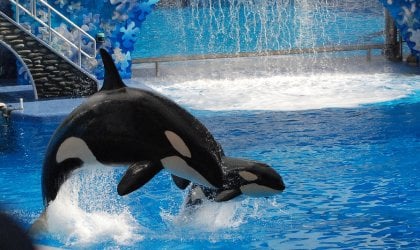SeaWorld aggressively markets its animal experiences and shows to families with toddlers and other children. But is SeaWorld kid-friendly? Let’s take a deep dive to determine whether its marine parks are safe or educational for kids.

Is SeaWorld Safe for Children?
SeaWorld teaches children the dangerous lesson that it’s acceptable to handle wild animals against their will. Past incidents involving animals and health risks from animal encounters raise concerns about whether its parks are safe for visitors, especially children. PETA has shared documented cases in which animals at SeaWorld have injured visitors and employees.
Animal Incidents at SeaWorld Involving Kids
At SeaWorld San Antonio, a dolphin latched onto the hand and wrist of a 9-year-old girl so tightly that her mother was unable to free her and a park employee had to intervene. At SeaWorld Orlando in Florida, an 8-year-old girl feeding fish to a dolphin was bitten on her hand when the animal lunged to grab the food.
These smart, sensitive animals, deprived of their freedom and everything that’s natural and important to them, grow increasingly frustrated and can behave unpredictably, which contributes to the risk of violent incidents occurring.
Are Touch Tanks Safe for Kids?
Touch tanks, which allow direct contact with marine life, can cause viral, fungal, and bacterial infections, endangering both the animals confined to them and humans. The aquatic animals in these tanks are unable to escape groping hands that can contaminate the water with bacteria. SeaWorld isn’t safe for visitors or animals.
Children Witness Carnage at SeaWorld
PETA received eyewitness footage from a SeaWorld visitor showing a violent attack involving orcas at its park in San Diego during which at least one of the animals sustained a serious wound. In the footage, a child can be heard asking, “How is [the orca] still alive?” and “I thought they hug each other, not fight each other.”
How Educational Is SeaWorld for Children?
Kids would run kicking and screaming from SeaWorld if they knew that more than 40 orcas, over 500 other dolphins and whales, and countless other animals have died at the parks, many prematurely.
SeaWorld disingenuously promotes itself as educational, offering programs and field trips for children. However, a number of concerns raise significant doubts about the true educational value of SeaWorld, including the following:
- Animals at SeaWorld are forced to perform meaningless tricks. Seeing them balance balls on their noses or jump through hoops on command doesn’t teach children about the normal behavior of orcas and other dolphins.
- The parks relegate ocean-dwelling animals to a world that’s measured in feet instead of fathoms and bears no resemblance to their natural habitat. In the wild, orcas can dive more than 3,500 feet, but the deepest tank at SeaWorld is only about 34 feet deep. In nature, dolphins can swim up to 60 miles each day. In captivity, they can only swim in endless circles inside tiny tanks. SeaWorld’s shows are anything but educational.
- Despondent orcas, denied everything that gives their lives meaning and purpose, often sustain broken teeth from biting on the metal gates and concrete sides of their tanks. This results in severe dental trauma, including painfully exposed roots. This tooth damage can lead to the need for chronic antibiotic therapy, which can compromise orcas’ immune systems.
- All captive adult male orcas have collapsed dorsal fins,which are rarely seen in nature. This likely occurs because they have no space in which to swim freely, spend long periods of time floating listlessly at the surface of the water, and are fed an unnatural diet of thawed dead fish.
- SeaWorld trainers usually have no formal education in marine biology. Their purpose is to entertain visitors, not educate them.
- SeaWorld crams dolphins into tiny tanks, breeding them—sometimes forcibly after they’ve been drugged—and abusing them. Visiting the parks sends the message to young people that hurting orcas, other dolphins, and whales and treating them with disrespect is OK. There’s nothing educational about SeaWorld, which deprives living, feeling beings of everything that’s natural and important to them—like diving deep and swimming long distances—all for the public’s fleeting diversion.
Kids who care about animals will want to learn about Corky, the longest-held captive orca in the world, and how they can help her.
Is SeaWorld Worth Visiting With Children?
Taking kids to SeaWorld teaches them that it’s OK to support businesses that force animals to endure a miserable existence, simply to provide humans with a few moments of fleeting entertainment. Check out the many cruelty-free choices available below.
What to Do Instead of Visiting SeaWorld
Things to Do in California With Toddlers and Other Children
- Visit the coast and go boogie boarding or take surfing lessons.
- Stroll through a botanical garden.
- Check out an animal-free museum like the Maritime Museum of San Diego, which is known worldwide for restoring, maintaining, and operating historic ships. You can check it out and even take a cruise there.
Kid-Friendly Activities in Florida
- Visit any of the state’s beaches and look for dolphins in their ocean home.
- Check out some of the state’s many bays and bayous in a rented paddleboard or kayak.
- Explore the Great Florida Birding and Wildlife Trail, which stretches more than 2,000 miles across the state and contains 515 habitats. Bring your binoculars!
Fun Things to Do in Texas
- Take a hike through one of the state’s national parks.
- Go underground in one of Texas’ natural caverns.
- Rent a bike and start pedaling on Texas’ extensive bike trail system.
What You Can Do
Families should never visit SeaWorld or any other marine park. Please urge SeaWorld to release Corky the orca to a seaside sanctuary:




